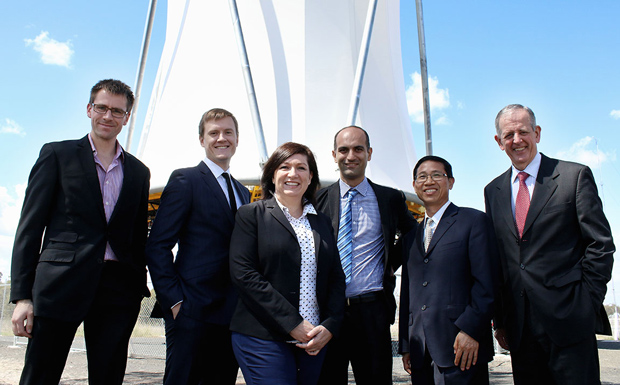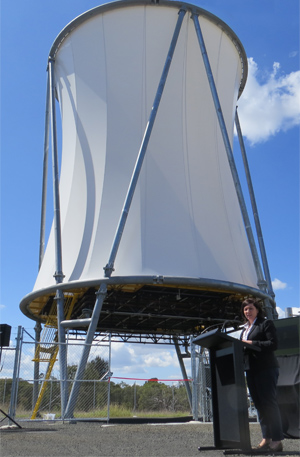

(Photo: UQ)
September 23, 2015
The State Government says new technology developed in Queensland promises to revolutionise the electricity industry, leading to a cheaper, more reliable source of energy in drought-affected areas.
The hybrid cooling tower technology at the University of Queensland’s Gatton campus is aimed at reducing the amount of water used in thermal power generation, a major issue for arid and drought-affected regions.
On Wednesday, Science Minister Leeanne Enoch officially opened the University’s new test research facility at Gatton where the technology is being further developed for potential domestic and international use.
Ms Enoch said the university’s hybrid cooling tower technology could transform electricity generation in Australia and overseas, by cutting water consumption and operating costs.
“Water conservation is a significant challenge in arid areas and there is a substantial market for technologies that make the most efficient use of this valuable resource,” Ms Enoch said.
“In Queensland, we’re well aware of how precious water is and we know that in drought, you can’t afford to waste a single drop.
“Electricity generation requires large quantities of water and, in response to this challenge, research organisations worldwide are seeking to develop efficient cooling technologies that reduce water consumption.
“The University of Queensland has taken a giant leap forward in this field with the development of this hybrid cooling tower test facility.”
Ms Enoch said the 20-metre cooling tower at Gatton was made possible thanks to a $1.5 million investment by the State Government in 2012.
Lead researcher Dr Kamel Hooman said the research aimed to reduce water consumption in future Queensland power generation plants by more than 70,000 megalitres per year by 2020, equivalent to about 28,000 Olympic-sized swimming pools.
“The hybrid cooling tower technology uses a combination of water and air cooling, depending on the conditions,” he said. “It operates in the ‘dry’ mode, which requires no water, for a majority of the year,” Dr Hooman said.
“For very hot days, commonly less than two weeks a year in Queensland, thermal power generation efficiency can be maintained without having to evaporate copious amounts of water.
“The technology offers the prospect of making geothermal and solar thermal power generation viable in regional areas suffering from drought. The implications of this are huge – offering up a reliable electricity supply without posing a significant environmental cost on rural communities.”
The research team was also involved in developing a low-cost solar thermal power plant suitable for regional Australia.
Dr Hooman said the development of an efficient cooling tower was a necessary precursor to low-cost solar thermal power generation.
“The work being done here at Gatton by Dr Hooman and his team clearly demonstrates the effectiveness of targeted government investment in science,” Ms Enoch said.























